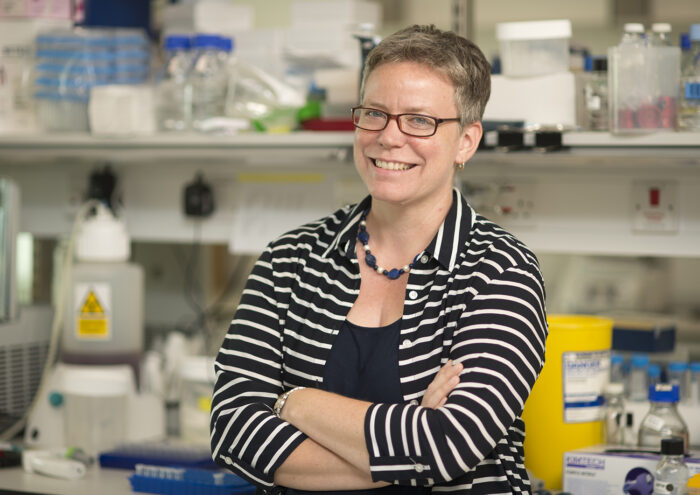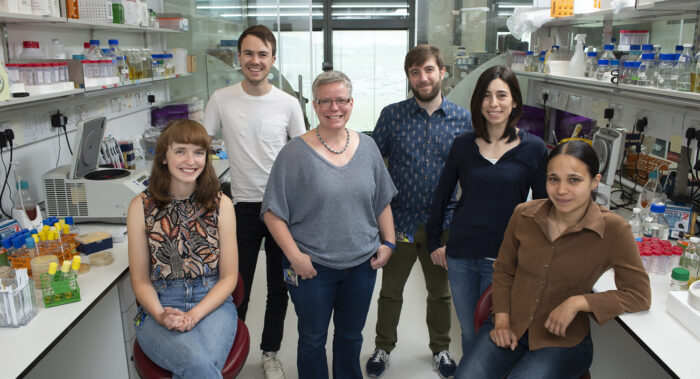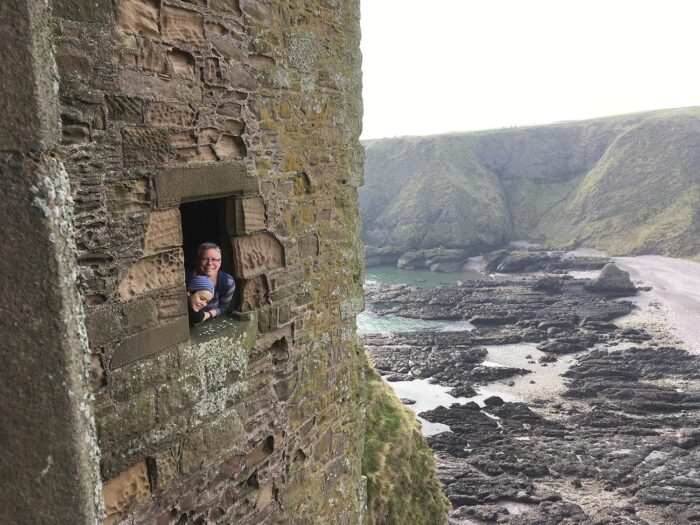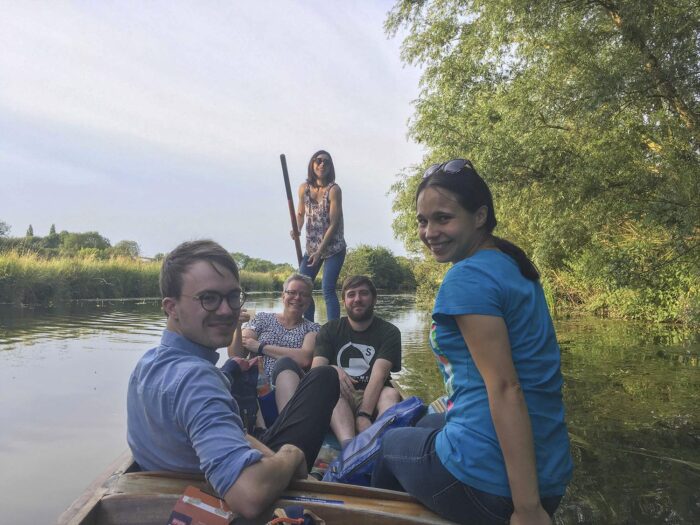Liz Miller: Signed, sealed, delivered – protein trafficking in the endoplasmic reticulum

Liz Miller’s lab works on a problem that would severely perplex even the most efficient postal service: how does the cell sort, address and dispatch the many thousands of secreted and membrane proteins made and folded in the endoplasmic reticulum (ER)? Such proteins make up about a third of the eukaryotic genome and are the bedrock of a cell’s ability to respond to and modulate its external environment. In an added twist that the Post Office doesn’t have to worry about, if unfolded proteins accidentally get packaged and escape the ER, the toxic fallout can be fatal to the cell.
Whilst quite a lot is known about the individual components of the system, it’s still not at all clear how the cell knows which proteins are properly folded and ready to leave the ER, or how they’re correctly addressed so that they end up in the right place. And even the vesicles in which the proteins are parcelled up to be exported are a bit of a mystery: it takes a tremendous amount of energy for the ER to bend its membranes to make the highly curved spherical transport capsules, and how the cell recoups its energy investment is not obvious.
Using yeast as a model system, Liz and her lab use a combination of genetic manipulation, biophysics and imaging to attack the problem, and it’s in these latter two areas that she benefits most from being at a place where interdisciplinary collaboration is inbuilt. After hearing him talk in a new group leaders’ seminar series, Liz realised that her colleague Madan Babu, who works on intrinsically disordered proteins, could help her a lot in understanding how the vesicles are assembled. “We now think that the aggregate effect of many, many weak multivalent interactions, exactly the sort of thing that Madan is studying, is to build these amazing structures, which must be assembled but also easily disassembled for recycling”, Liz says. “Having these kinds of colleagues and interacting with them just opens up your eyes to different ways of approaching your problem. Using classical biochemical assays, we were really limited in what we could detect.”

In collaboration with resident LMB expert Wanda Kukulski, the Miller lab has also started using correlative light and electron microscopy, and it’s been revelatory: “the crowdedness of the cells is just incredible”, says Liz. “If you look at a sheet of ER, there are ribosomes lined up over the entire surface, and it makes you appreciate that perhaps one of the problems in making a vesicle is actually to clear away the ribosomes and make a bare patch of membrane. It’s a miracle anything gets done, it’s so crowded!” Since working with Wanda and her lab, Liz says they’ve “discovered some surprising things that we have great confidence in, because of the very high quality of our data. And this comes from students and post-docs training with excellent colleagues supported by first-rate infrastructure.”
Liz’s fascination with vesicle trafficking began as a PhD student with Marilyn Anderson at La Trobe University in Melbourne, but her subsequent postdoc in the area, with future Nobel Laureate Randy Schekman, was almost accidental. On a trip to the US for a conference in the second year of her PhD, she arranged to visit a few trafficking labs to see what they were doing, and was very surprised when she was subsequently offered postdoc positions. “In retrospect I was impossibly naïve”, she says, “I’d read the trafficking papers in the top journals and wrote to the people who were publishing them. I didn’t fully appreciate I was having job interviews – I just thought we were talking about science!”
The move to Schekman’s large, well-funded lab at Berkeley was a huge change from the small biomedical science community in Australia, but Liz remembers it as the best time of her whole career. “I had no responsibilities, no kids, I was surrounded by fantastic students and postdocs at the same intellectual level, and we talked about science the whole time,” she says. “That intellectual peer group is very precious – once you start your own lab, you have to build that from scratch yourself, and it takes a very long time.”

After five years at Berkeley, Liz moved to New York to take up an Assistant Professorship in the Department of Biological Sciences at Columbia, whilst her husband Marcus, a fellow Australian who’d also been a postdoc with Schekman, changed field and did a second postdoc. In 2013, Liz became the first woman tenured from within her department for thirty-two years, something she is rightly very proud of.
Despite Liz having the security of tenure, she and Marcus started looking for other places to live and work, as the economic climate meant that it was unlikely that Marcus would also be able to find a permanent academic job in New York. To see whether the LMB might suit her, Liz came for a two month mini-sabbatical: “It was a try-before-you-buy situation where we all could see how I would fit as a colleague”, she laughs. Fortunately, it quickly became clear that Liz and the LMB were a very good match, and when Marcus was offered a faculty position at the Sanger Institute, the couple decided to move, together with their young son.
Just over five years later, Liz is still very happy with her choice. As well as the delights of collaboration, the LMB ethos of keeping one’s lab small suits her very well, especially as she’s been able to get back to doing experiments herself. “I love being back at the bench again – it’s awesome!”, she says. “The job I’ve given myself is to do preliminary experiments on new projects to make sure there’s something there before handing it on. The small lab size means you have to be careful to focus, and you have to have confidence your idea is going to pan out.”
Liz also relishes the extra time that freedom from teaching and writing grants gives her: “I can guide my lab more intensively, and help students and post-docs see the big picture”, she says. “And I’ve also got so much more time to think deeply about things, in a way I haven’t been able to do for years.
Liz sees herself as an introvert, but one who has worked to build her confidence, and giving younger women that same confidence to put themselves forward is something she’s committed to. “If you come across as just a little bit hesitant, it’s too easy for people to ignore what you have to say”, she suggests.

External validation and effective mentoring really matters: “We don’t tell people they are good as often as we should – we are very restrained with our praise, especially in science”, Liz says. “Men don’t appreciate that women sometimes need to be reinforced and told ‘you’re ready for this, you can do it and you should do it now’!”
On the thorny subject of work-life balance in science, Liz is clear that many of the issues are for both sexes to consider. “We should not continue to accept that families are a “women in science” problem”, she says, “because that attitude lets men off the hook in the co-parenting stakes.” However, having visible senior scientific women as role models will continue to be of great importance for younger women looking to build a life in science.
Although she didn’t realise at the time, Liz’s PhD supervisor Marilyn Anderson was a great role model for a young woman starting out in academia. “She had kids, and she was out the door when she needed to go”, Liz says. “She showed me what life looked like with kids and a demanding job, so I always knew that it was possible. There needs to be an open discussion about how you juggle things, and that it’s difficult but also amazingly rewarding and very flexible. Nobody is tracking my time, and if my son is sick, as he was last week, I can cancel things and I can stay home. It’s a much more flexible arrangement for having a life than many alternative careers. Young women need to be shown that they’ll be able to manage.”
“Having senior women who can say ‘I didn’t have a plan for this, I didn’t have much self-confidence, but I loved doing science and wanted to keep doing it’, is how you show that you can still be successful without having thought it through twenty years ahead of time”, says Liz. “My advice to anyone wanting to take this path is to make sure you really enjoy it, and then try not to get stressed about the future – it’s going to happen anyway!”
This article is based on an interview by Kathy Weston, February 2019.